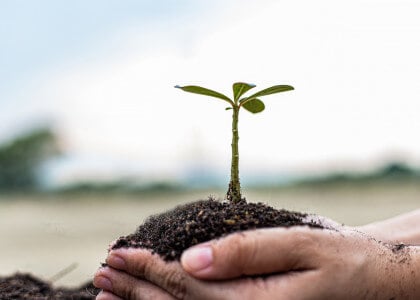1. Select plants suited to normal precipitation levels
 Left: Butterfly Weed, top right: Smooth Blue Aster, bottom right: Shenandoah Red Switchgrass
Left: Butterfly Weed, top right: Smooth Blue Aster, bottom right: Shenandoah Red Switchgrass
By choosing plants that align with your area norms, you reduce their irrigation needs. That’s true for arid-loving plants in dry climates, and moisture-loving plants in wetter zones. Native plants, such as the Shenandoah Red Switchgrass, are great starting points for water-wise planting schemes.
2. Understand your soil type and plant needs

Your soil influences how much water plants need. By understanding your soil, you can amend as needed to create environments where plants thrive. For example, extra organic matter can improve both light and heavy soils so they drain well, yet retain moisture, too.
3. Group plants with similar water requirements
 Left: Royal Red Butterfly Bush, right: May Night Salvia
Left: Royal Red Butterfly Bush, right: May Night Salvia
By considering moisture needs and grouping like plants together, you can focus water where it’s needed instead of where it’s not. As an added bonus, massing plants together helps attract pollinators to your garden as well.
4. Plant with your yard’s microclimates in mind
 Left: Blondy Wintercreeper, top right: Color Guard Yucca, bottom right: Double Play Candy Corn Spirea
Left: Blondy Wintercreeper, top right: Color Guard Yucca, bottom right: Double Play Candy Corn Spirea
Microclimates are areas such as warm spots next to your home’s foundation or cool, shady garden spots under trees. These areas may lose or retain moisture at different rates than other parts of your yard, so match plants and care accordingly. Have a dry spot in your yard? Consider a drought tolerant spirea.
5. Protect planting beds with a layer of mulch

Whatever mulch option you choose, a mulch layer can help retain moisture and prevent temperature fluctuations in soil. Follow good practices for mulching. A 2- to 3-inch layer cuts down on weeds, which compete with plants for water, and it gives your landscape a finished look, too.
6. Use drought- and heat-tolerant lawn grasses
 Left: Prairie Dropseed, top right: Blue Oat Grass, bottom right: Karl Foerster Feather Reed Grass
Left: Prairie Dropseed, top right: Blue Oat Grass, bottom right: Karl Foerster Feather Reed Grass
Resilient grasses need less irrigation to stay healthy and green. You may also want to take a look at lawn alternatives, such as low-maintenance groundcovers, that look great with less supplemental watering.
7. Water to encourage deep root growth
 Pictured: Francis Williams Hosta
Pictured: Francis Williams Hosta
Shallow, frequent watering encourages shallow roots, which are more susceptible to heat and drought. Deep, infrequent watering encourages roots to go deeper, where they’re protected against heat and moisture loss.
8. Water early in the morning
 Pictured: Hansa Rose
Pictured: Hansa Rose
When you water early, water can soak in instead of evaporating in the sun’s heat. Early watering is better for plant health, too. Wet leaves promote some fungal plant diseases. Water early and leaves dry well before evening comes.
9. Avoid overhead watering
 Pictured: Drip Irrigation systems at McKay Nursery
Pictured: Drip Irrigation systems at McKay Nursery
Overhead watering systems, including high-arching sprinklers, lose water to wind and evaporation, plus they leave foliage wet and vulnerable to disease. Use sprinklers with low trajectories or use drip irrigation instead.
10. Don’t leave irrigation systems on autopilot

Monitor rainfall and adjust watering schedules to run only when needed. Consider using intervals that let the water soak in between runs. Check heads regularly, and don’t water sidewalks and driveways. Send water to plants, not into streets.
With a landscape created around sustainability and the water-wise life, you’ll have less maintenance, lower water bills, healthier plants, and more time to enjoy the garden and landscape you’ve built. Shop our plants online for in-store pickup, local truck delivery, or Fed-Ex delivery anywhere in the continental United States.

